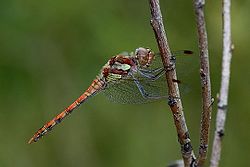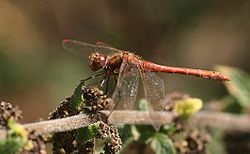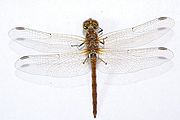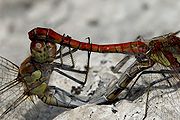Common darter
| Common darter |
|---|

|
| Scientific Classification |
|
| Binomial Name |
|
Sympetrum striolatum |
| The common darter is landing on a branch |
The Common darter is a species of dragonfly known by the scientific name Sympetrum striolatum . They are distinguish by the dark spots on the wings, narrow-bodies, bright red males and golden-brown females and immature adults.[2]. The common darter is the most common dragonfly in Europe. Their life span is short, some of them lasting no more than a week or two, but in rare cases some live 6-8 weeks. The adult form is most active between mid-morning and mid-afternoon when the temperature is highest.
Body Design
The common darter have pattern of red and orange on the abdomen of the male. This pattern is different from other dragonfly. [3] They have three pairs of jointed appendages, exposed mouth parts, an exoskeleton, and two pair of wings with many veins and cross veins. They have one pair of short antennae, abdomens that are long and slender, and large compound eyes. Separate from other species, the common darter has black legs with yellow streaks. The length of the legs is approximately 3.8-4.3 centimeters.[4] The gills are located internally. The compound eyes of some dragonflies have up to 28,000 facets. Females will mate only with males that hold a territory.
Life Cycle
The life span of common darter typically lasts a year. There are three stages in their incomplete metamorphosis: egg, nymph, and adult. They exist in the nymph stage for the majority of their life (humans cannot see them with the naked eye).
Egg Stage: A male and a female will mate while flying in the air. After mating, the female will lay her eggs in the water.
Nymph Stage: When the eggs hatch, the life cycle of larva begins as a nymph, an aquatic larval stage. Nymphs live in ponds or lake areas. They lived in the water while they grow and develop into adults. This stage can take up to five years to complete. Nymphs sometimes eat other smaller nymphs during development. When the nymph is fully grown, it will complete the metamorphosis by first climbing onto a leaf. The larvae will sit in the water near the margin for several days to get ready for their final molt and start changing the breathing pattern inside their body. The larvae climb up to find a secure spot then the skins slit on a weak point located behind the head. First, they push the thorax, head, legs, and wings out of the larval skin. Then, they pause for about 30 minutes to let their legs harden enough for the next stage, which is when the abdomen is backed out. The wings and abdomen are expanded and start to become solid. After a while, the adult will have hardened wings so they can begin flight. The adult will come out as a dragonfly. The skin that adult leaves behind is called the exuvia.
Adult Stage: After a while, the male will find a mate. The female locate a body of water to lay her eggs in the water. The adult lifespan from lasts around two months. [5]
Ecology
The Common Darter feeds on large numbers of small flying insects. They can even capture and eat honey bees. They are used for medicinal purposes in Japan and China and also as food source, eaten both as adults or larvae.
Common Darters inhabit a wide range of still water areas including ponds, lakes, pools, and the calm waters of slow flowing rivers. They also are able to colonize brackish waters. The larvae are often found along the bottom of a water-body or in aquatic vegetation close to the surface. They mostly live in Europe, especially United Kingdom. Some of them can also be found in South Korea. [6]
References
- Sympetrum striolatum. wwww.eol.org. Web. November 11, 2011.
- Common Darter. www.scottishwildlifetrust.org.uk. November 11, 2011.
- Meyer, John. ODONATA. http://www.cals.ncsu.edu. Web. March 5, 2005.
- Dragonfly life cycle. www.dragonfly-site.com. Web. November 20, 2011.
- Common Darter. http://homepage.ntlworld.com. Web. June 2006.



